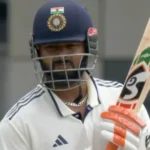Penalty Drama in Kowloon: India’s Blue Tigers Secure Victory in AFC Asian Cup Qualifiers
The smell of instant noodles hung thick in the humid Kowloon air, a weirdly comforting scent considering the tension practically vibrating through the Kai Tak Stadium. I’ve been around football – really *around* it, not just watching on TV – for over twenty years, and I thought I’d felt every kind of pressure imaginable. Playing youth leagues in a tiny village in England, scouting for smaller clubs across Europe, even a short, spectacularly unsuccessful stint as a lower-league kit man… you pick up a sense of what moments *matter*. But last night? Last night in Hong Kong felt different. It wasn’t just a game; it was a pressure cooker, and India’s Blue Tigers just walked out with the lid still on, victorious.
Let me back up a bit. My name’s Alistair Finch, and I’m a football analyst – plain and simple. I don’t have a fancy broadcasting gig or a column in a major paper. My work is quieter. I spend a lot of time digging into the details, the stats, the player movements, the tactical choices that most fans wouldn’t even notice. I build reports for smaller clubs, offer insights to agents, and generally try to understand what makes the beautiful game tick. I’ve focused a lot on Asian football over the last decade, fascinated by the growth and evolution of the sport in countries like India, Qatar, and Japan. It’s a world away from the Premier League hype, but it’s full of brilliant players and increasingly sophisticated tactics.
I was in Kowloon not as press, not as a scout, but as a friend to Sunil Chhetri’s fitness coach, a fella named Eduardo. Eduardo and I go way back to a pre-season camp in Portugal where we both realized how much we *really* disliked early morning sprints. We’ve stayed in touch, trading notes and observations about the game ever since. He invited me along to get a firsthand feel for the Hong Kong atmosphere and to lend an extra pair of eyes to the Indian team’s performance. It was an offer I couldn’t refuse.
From the moment we landed, you could feel the energy. Hong Kong’s football fans are passionate, bordering on feverish, especially when it comes to international matches. Kai Tak Stadium, recently renovated, was bouncing. It wasn’t *packed* in the way a Champions League night would be, but the noise was constant, a blend of Cantonese cheers and the rhythmic drumming of hardcore supporters. What struck me immediately wasn’t just the volume, but the *informed* nature of the crowd. They weren’t just blindly cheering; they understood the game, they knew the players, and they weren’t afraid to let their opinions be heard.
Now, let’s be real. India and Hong Kong aren’t exactly footballing giants. Hong Kong, historically, has been a solid, organized team, often relying on a disciplined defense and quick counter-attacks. They’re not going to out-possess Barcelona, but they’re tough to break down. India, on the other hand, has been on a slow but steady climb. Sunil Chhetri, their captain and a legend of the game, is still a force at 38, and the emergence of younger players has added some much-needed dynamism to the squad. But consistency has been the problem. They’ve had flashes of brilliance, heartbreaking near-misses, and a frustrating tendency to stumble against teams they should beat.
Going into the match, I was cautiously optimistic. I’d spent the week leading up to the game analyzing Hong Kong’s recent performances, looking for weaknesses. Their midfield lacked a true playmaker, relying heavily on long balls and hopeful through-balls. Their left-back was vulnerable to pace and trickery. But they were incredibly organized defensively, and their goalkeeper, Yapp Hung Fai, is a seasoned veteran, known for his agility and shot-stopping ability.
India, meanwhile, had been working on a more fluid, attacking style under Igor Štimac, the Croatian coach. He’s a demanding coach, known for his directness and tactical flexibility. I’d heard whispers that he was pushing the players to be more confident on the ball, to take more risks in the final third. The starting lineup confirmed that; it wasn’t the overly cautious approach we’ve often seen from India in the past.
The first half was exactly as I’d predicted: a tight, tense affair. Hong Kong sat deep, absorbing India’s pressure, and looking to hit them on the break. India dominated possession, but struggled to create clear-cut chances. Chhetri was constantly looking for space, trying to drag defenders out of position, but Hong Kong’s defense was well-drilled, closing down the gaps and winning crucial tackles.
What surprised me was the physicality of the game. This wasn’t a silky, possession-based affair. It was a proper battle, with crunching tackles and a lot of off-the-ball jostling. The referees allowed a fair amount to go on, which suited Hong Kong’s style of play. They were happy to get stuck in, to disrupt India’s rhythm.
The midfield battle was particularly fierce. Hong Kong’s Tan Chun Lok was a relentless destroyer, breaking up play and winning back possession. India’s Anirudh Thapa tried to dictate the tempo, but he was constantly harried and pressured. I noticed that Hong Kong were deliberately fouling Thapa whenever possible, trying to knock him off his game. It was cynical, but effective.
The first half ended scoreless, which, frankly, wasn’t a surprise. I spent the halftime break chatting with Eduardo, reviewing the key moments and discussing potential adjustments. We both agreed that India needed to be more patient in their build-up play, to avoid forcing passes and to look for opportunities to switch the point of attack. Eduardo also pointed out that Chhetri looked a little isolated up front, and suggested that the wingers needed to get closer to him to provide support.
The second half started with a renewed sense of urgency from India. They came out firing, pushing higher up the pitch and creating more chances. However, Hong Kong remained resolute in defense, and Yapp Hung Fai continued to frustrate the Indian attackers with a series of brilliant saves. He’s seriously good, that goalkeeper.
Then, in the 74th minute, the breakthrough finally came. A beautiful through-ball from Brandon Fernandes split the Hong Kong defense, and Chhetri was there to latch onto it. He took a touch, composed himself, and slotted the ball past Yapp Hung Fai with a cool finish. The stadium erupted, a wave of blue washing over the stands. Pure elation. Even I, a (relatively) objective analyst, couldn’t help but smile. It was a moment of pure magic from a player who has given everything for Indian football.
But, as anyone who knows football knows, 1-0 is never enough. Especially not in a game as tense as this. And Hong Kong, to their credit, didn’t give up. They threw everything they had at India in the final fifteen minutes, launching wave after wave of attacks.
And then came the gut punch. In the 82nd minute, Hong Kong won a penalty. A clumsy challenge in the box, a clear foul, and the referee had no choice. I held my breath. This was it. One mistake, one save, could decide the game.
The Hong Kong player, Sin Ka Lam, stepped up to take the penalty. He struck the ball well, sending it towards the bottom corner, but Gurpreet Singh Sandhu, India’s goalkeeper, guessed right. He dived full stretch, getting a strong hand to the ball and pushing it around the post. The stadium fell silent, a collective gasp of disbelief. Gurpreet’s save was absolutely monumental. It wasn’t just a good save; it was a save that came at the most crucial moment, a save that lifted the entire team and renewed their belief.
But the drama wasn’t over. In the dying seconds of injury time, Hong Kong won another penalty. Another controversial decision, another moment of heart-stopping tension. This time, the Hong Kong player, Wu Chun Ming, stepped up.
Again, Gurpreet dived the right way, but this time, the ball was just beyond his reach. It nestled into the bottom corner, sending the game into a penalty shootout.
Now, penalty shootouts are a lottery. Pure and simple. It’s a test of nerve, a battle of wills. It doesn’t matter how well you’ve played during the game; it all comes down to those few seconds, that one kick.
I’ve seen so many shootouts in my time, and they always feel the same: agonizingly slow, filled with tension and uncertainty. The walk from the halfway line to the penalty spot feels like an eternity for the kicker. The goalkeeper trying to psych them out with his movements. The fans holding their breath. It’s excruciating.
India went first. Chhetri, naturally, stepped up. He calmly slotted the ball into the bottom corner, sending Yapp Hung Fai the wrong way. 1-0 to India. Hong Kong responded with a successful penalty of their own. 1-1.
The shootout went back and forth, each team converting their penalties with ice-cold composure. The tension was unbearable. After five rounds each, the score was still tied at 4-4.
It came down to sudden death. India’s next kicker, Ashique Kuruniyan, stepped up and buried his penalty in the top corner. 5-4 to India. Hong Kong’s next kicker, Lam Ka Wai, hit the post.
Pandemonium.
The Indian players erupted, mobbing Gurpreet Singh Sandhu, the hero of the shootout. The fans in the blue shirts went wild, celebrating a hard-fought, incredibly dramatic victory. Even the more reserved members of the Indian coaching staff were visibly relieved and overjoyed.
I found Eduardo amidst the celebrations and we shared a weary but satisfied grin. “That,” he said, wiping sweat from his brow, “was closer than I ever want to be again.”
I nodded in agreement. It *was* close. Incredibly close. But India had done it. They had secured a vital win in their AFC Asian Cup qualifying campaign.
But the victory wasn’t just about the result. It was about the resilience, the determination, and the sheer grit that the Indian team had shown. They had faced adversity, they had overcome setbacks, and they had emerged victorious.
What did I take away from being there? Beyond the stat sheets and tactical observations, it reinforced something I’ve always believed: football is about more than just skill and tactics. It’s about heart, about passion, about the unwavering belief in yourself and your teammates.
India’s performance wasn’t perfect, far from it. They were sloppy at times, they made mistakes, but they never gave up. They fought for every ball, they challenged for every header, and they defended with their lives. And in the end, that’s what made the difference.
The qualification isn’t a guarantee of success in the Asian Cup itself – the competition will be fierce, with teams like Japan, South Korea, and Iran all vying for the title. But this victory in Kowloon was a significant step forward for Indian football. It showed that they can compete with the best teams in Asia, and it gave them a much-needed boost of confidence.
We grabbed some late-night dim sum – seriously, the food in Hong Kong is amazing – and I started compiling my notes. Analyzing the game, reliving the moments, trying to understand what made it all happen. This isn’t a glamorous job, but moments like these, witnessing the raw emotion and the thrill of victory firsthand, make it all worthwhile. The journey to the Asian Cup will be long and arduous, but what I saw in Kowloon gives me hope. The Blue Tigers are on the rise, and I, for one, can’t wait to see what they can achieve.
Anurag Dhole is a seasoned journalist and content writer with a passion for delivering timely, accurate, and engaging stories. With over 8 years of experience in digital media, she covers a wide range of topics—from breaking news and politics to business insights and cultural trends. Jane's writing style blends clarity with depth, aiming to inform and inspire readers in a fast-paced media landscape. When she’s not chasing stories, she’s likely reading investigative features or exploring local cafés for her next writing spot.






